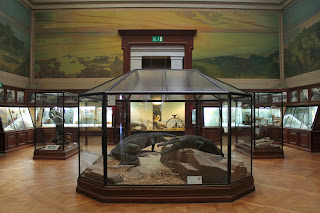In a couple of days my husband and I will board a plane for the States, where we'll visit friends and celebrate the Christmas holidays with my family. It'll be the first time in three years that we're back in the USA for Christmas, and I can't wait.
Not that I don't enjoy the holiday season here in Belgium. The old Flemish cities are at their picturesque best this time of year, with all the Christmas greenery and lights. Christmas markets are sprouting up everywhere, and I've already drunk my fill of mulled wine, whipped cream-topped hot chocolate and flavored jenevers at Hasselt's Winterland, which is like a sugar-fueled, Santa-themed carnival on acid.
 |
| Hasselt's Winterland |
But there's something special about Christmas in America, and it's just not the same here. No other holiday comes close in terms of nostalgia, anticipation, excitement and excess. Christmas isn't only the biggest holiday of the year—it's the one that is most closely bound up with our childhood memories, our family dynamics, and our favorite rituals, whether religious or secular.
Of course, there are all the negatives: the commercialism, the expectations, the disappointment. Everyone complains about the pressure to buy more (and more expensive) gifts. The stress of attending all those holiday parties and managing holiday schedules. The powder keg of emotions that any family gathering inevitably becomes... and the depression that can easily take hold when the reality of the holidays doesn't match our dreams.
But that's the dark side of a holiday that's all about light. For most Americans, Christmas is about getting together with our loved ones and sharing a meal while dressed in our prettiest party clothes. It's about decorating the house, putting up the tree, and hanging up ornaments that have been carefully collected over the years. It's about listening to Christmas carols on the radio, even the ones we claim to hate. It's about finding the perfect gift for your favorite aunt, and sending Christmas cards the old-fashioned way, by mail.
 |
| Christmas tree in the Grand Place, Brussels |
I've found that Christmas in Belgium doesn't have the same emotional pull for people here. Children have Sinterklaas on December 6, when they receive special treats and presents. That's the holiday most people associate with cherished childhood memories. Traditionally, families would go to church on Christmas eve, eat dinner together and maybe open presents. It just wasn't a big deal. It seems that many of the Christmas traditions now seen in Belgium have been imported from Germany, England or America in recent years.
This year, I'm looking forward to my family's Christmas traditions: We'll dress up and go to church on Christmas Eve, and then my aunt will host a party afterwards with cocktails, egg nog and lots of food. On Christmas morning, we'll open our stockings (stuffed with small gifts and treats from “Santa”) in our pajamas, and then get dressed for a late breakfast. After breakfast, we'll open the piles of presents under the tree. Later we'll go for a winter walk on the beach before starting on dinner preparations.
Christmas dinner will be a formal affair with fancy dishes and the good silver. It will be followed by a Christmas pudding (purchased at the English shop in Brussels and brought over on the plane) crowned with a holly sprig, doused in brandy and lit on fire. Everyone will be slightly tipsy by then and we'll finish by pulling our crackers and reading the bad jokes while wearing paper crowns. (NB: many of our Christmas traditions are British, since my family is from England.)
 |
| My family's Christmas table |
Last year, we went to my Flemish in-laws' house on Christmas Day for a family dinner. It was very relaxed and not so different from other family gatherings. We didn't exchange presents. But there are a few Christmas traditions that I refuse to give up, even here in Belgium. I insisted on having stockings for myself and my husband (even though I had to fill both of them myself). I drove my husband crazy by playing Christmas music for weeks. And I decorated our Christmas tree with the ornaments I've been collecting for over 20 years, which were among the few things I brought with me from America.


























